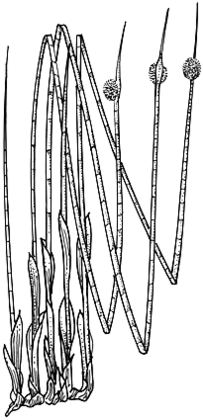
Description: Rhizomatous perennials. Culms glabrous, terete, transversely septate, longitudinally uni- or pluritubulose, hollow between septa.
Leaves basal, occasionally all reduced to sheaths; when present, blade terete, transversely septate, longitudinally uni- or pluritubulose.
Inflorescence head-like, compact, pseudolateral, with numerous pseudospikelets on a solid core; lowest involucral bract appearing continuous with culm, terete, much exceeding inflorescence. Each pseudospikelet composed of a few sterile glumes plus few–numerous glumes each subtending 1 stamen, plus 1 uppermost female flower. Glumes spirally arranged, thin-textured, white or pale brown at their base darkening towards their apex, becoming narrower and simpler in shape from base to apex of pseudospikelet. Style 2–4[or 5]-fid.
Nut woody, obovoid to globose, longitudinally ridged.
Distribution and occurrence: World: 6 species, Australia & New Caledonia. Australia: 5 species (4 species endemic), all States except N.T.
Text by K. L. Wilson
Taxon concept:
| | Key to the species | |
| 1 | Inflorescence narrow-ovoid to ovoid (rarely globose), with core not or scarcely raised, oblong to ovate; main involucral bract more or less sheathing sides of inflorescence, red-dotted; glumes glabrous; nut 2.7–4 mm long, red-brown; culms usually minutely verruculose as well as longitudinally striate | Chorizandra cymbaria |
| Inflorescence more or less globose, with core raised, conical; main involucral bract not sheathing inflorescence, not red-dotted; glumes more or less densely red-hairy near apex; nut 1.7–2 mm long, grey-brown; culms longitudinally striate but not verruculose | Chorizandra sphaerocephala |
|


